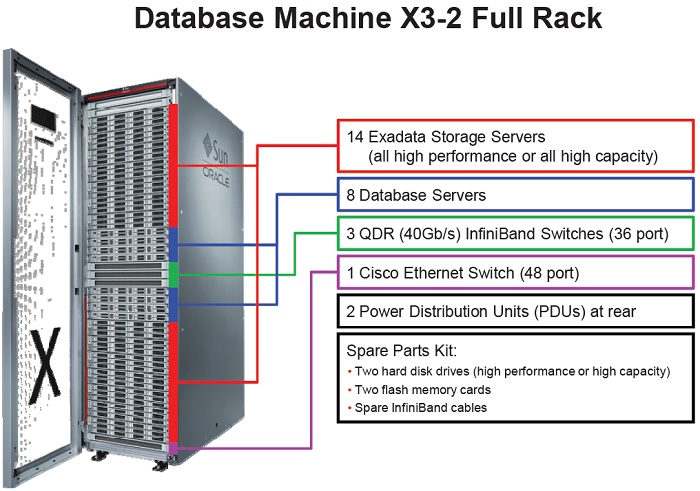This article is going to provide the overview about the Oracle’s Exadata database machine and the benefits of this engineering system. Oracle Database machine is fully integrated with oracle databases and it uses Exadata storage servers.This machine provides high performance and high availability for all type of database workloads.It also completely eliminates the all the bottlenecks and mainly IOPS. So you can simply consolidate multiple databases to one single database machine.These machines are very easy to deploy since one single script will be doing the job for you with help of Oracle Exadata Deployment Assistant (which generates the XML input file ).
Why do we need the database machines ?
Data warehousing issues:
Oracle database machine will support large and complex queries.Since the storage is connected to high speed infiniband networks ,you will be getting more than enough I/O throughput to support massive scans.Using the smart scan feature, it reduces unproductive I/O. It aslo supports the parallel processing to improve the system performance.It uses the hybrid column compression to reduce the storage space.
OLTP issues:
Database machines are completely eliminating the OLTP issues. It supports large user populations and transactions by providing the enough I/Os per second and caching frequently accessed data.It provides the consistent performance across all the tables and minimizing the IO latency.
Consolidation Issues:
To reduce the datacenter space , most of the companies are behind the virtualization technologies for small and mid range operations.How this database machine is address the consolidation issues ? In database machine , you can accommodate multiple workloads on same box instead of having the multiple database servers on your environment. You can also prioritizing the workloads but it requires proper analysis and planning prior to the implementation.
Configuration issues:
Database eliminates the configuration issues completely. Since only oracle is going to provide the support for complete database machine components , all the hardwares and firmwares will be compatibility with the oracle database software.It also creates the well-balanced configuration across the database machine to eliminates the bottlenecks.
Database machine consists following components on it.
- Exadata Storage servers (cell)
- Computing Nodes (Database servers – Typical oracle Linux x86_64 servers )
- Infiniband Switches (Internal networking )
- Cisco switches. (External networking )
- Power distribution units

| No of Exadata Stroage cells | No of Database Servers | No of Infiniband Switches | |
| Full Rack | 14 | 8 | 3 |
| Half Rack | 7 | 3 | 3 |
| Quarter Rack | 3 | 2 | 2 |
Exadata Storage servers:(cell)
Exadata storage server is exclusively designed for oracle database.It is a self contained storage platform and runs the Exadata storage software. Databases are typically deployed across multiple exadata storage servers to provide the vast performance. The databases (compute nodes ) and cell communicate with each other via infiniband network.(40Gb/s). Exadata storage server runs on oracle Linux x86_64 and storage is managed by Exadata cell software.
[box type=”note” ]You can’t allocate the Exadata storage to non-oracle database servers. The Exadata storage servers are exclusively designed to provide the storage to oracle databases within the Rack.[/box]

Exadata Storage Server X3-2 – Hardware Overview
| Processors | 12 Intel CPU cores |
| System Memory | 64GB |
| Disk Drives (If HPD) | 12×600 GB 15K RPM |
| Disk Drives (If HCD) | 12x3TB 7.2K RPM |
| Flash | 1.6 TB |
| Disk Controller | Disk Controller Host Bus Adapter with 512 MB Battery Backed Write Cache |
| InfiniBand Network | Dual-Port QDR (40Gb/s) InfiniBand Host Channel Adapter |
| Remote Management | Integrated Lights Out Manager (ILOM) Ethernet Port |
| Power Supplies | 2 x Redundant Hot-Swappable Power Supplies |
Exadata Storage Server X3-2 Configuration Options
Exadata storage servers is available in two type of configurations. q.HP(High Performance) disks 2. HC (High Capacity)disks. If you are looking for more storage space, then you need to choose the high capacity disk type (Ex: Dataware housing). If you need high performance (Ex: OLTP), You have to choose high performance disks.Please the below table to know the differences between the both configuration types.
| High Performance Disks | High Capacity Disks | |
| Raw Disk Capacity | 7.2TB | 36TB |
| Raw Disk Throughput | 1.8 GB/sec | 1.3 GB/sec |
| Flash Throughput | 7.25 GB/sec | 6.75 GB/sec |
X3-2 Database Server Hardware: Overview
Configuration:
| Processors | 16 Intel CPU Cores |
| System Memory | 256GB |
| Disk Drives | 4 x 300 GB 10K RPM Disk Drives |
| Disk Controller | Disk Controller Host Bus Adapter with 512 MB Battery Backed Write Cache |
| Remote Management | Integrated Lights Out Manager (ILOM) Ethernet Port |
| Power Supplies | 2 x Redundant Hot-Swappable Power Supplies |
| Network Interfaces | • Dual-Port QDR (40Gb/s) InfiniBand Host Channel Adapter • Four 1/10 Gb Ethernet Ports (copper) • Two 10Gb Ethernet Ports (optical) |
To know about x3-8 configuration click Page 2 to continue.
Leave a Reply